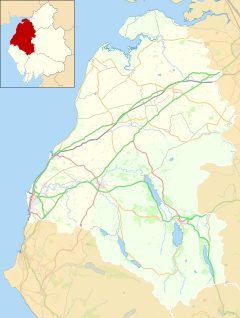| Kirkbampton | |
|---|---|
 Kirkbampton | |
| Population | 482 (2011) |
| OS grid reference | NY306564 |
| Civil parish |
|
| Unitary authority | |
| Ceremonial county | |
| Region | |
| Country | England |
| Sovereign state | United Kingdom |
| Post town | CARLISLE |
| Postcode district | CA5 |
| Dialling code | 01228 |
| Police | Cumbria |
| Fire | Cumbria |
| Ambulance | North West |
| UK Parliament | |
Kirkbampton is a village and civil parish on the B5307 road in the English county of Cumbria. The parish population taken at the 2011 census was 482. [1] It is near the city of Carlisle. It has a church called St Peter's Church, and a primary school (St. Peters CofE School). The parish includes the villages/hamlets of Kirkbampton, Little Bampton, Oughterby and Studholme.
Contents
The parish Church of Kirkbampton is dedicated to St Peter, and is an ancient Norman structure and a Grade I listed building, of typical Cumbrian character. The chancel arch and North doorway, both being original and in situ, are Saxon in style and fix the dimensions of the early Church. Over the North entrance door is a sculptured tympanum. Only five examples of these tympana exist is Cumbria, and the one at Kirkbampton, with its surrounding arch, is probably the most perfect, despite suffering from the weather. It is not now easy to decipher, but appears to be a figure and animals. A Roman stone found in the walls during restoration work in 1870-1871 is now built into the South wall of the chancel. It bears the inscription "VEX,LEG P.F. FEC.", and has probably been brought from the nearby Hadrian's Wall.

